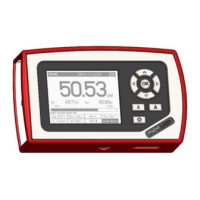5.3 Power Measurement of Pulsed Signals
- The detector noise is lowest with silicon or InGaAs sensors.
- For long term measurements in free space applications it is necessary to
provide constant ambient light conditions, or shielding the beam.
- The temperature should be stable over the time of the measurement.
5.3 Power Measurement of Pulsed Signals
The PM100D will read the average value of a pulsed signal when the following
conditions apply: For a thermal sensor pulse length, repetition rate and peak power is
uncritical as long as the peak power is lower than the damage threshold of the
sensor. A thermal sensor reacts very slow and will integrate the power incident on the
active area of the sensor.
With a photodiode sensor that can follow short pulses in the ns range it is important
that the pulse peak power is within the maximum power range of the sensor. It is also
important that the power range is set that accordingly the peak power is within this
range, otherwise the reading will clip at the range end and lead to a wrong average
value. Further it is important to use a power range in manual mode that can measure
the peak value, therefore the Min-Max function is very helpful. Depending on the
pulse length and repetition rate the bandwidth setting will influence the power
reading. It is recommended to use the low bandwidth setting for a stable display;
when the pulse should be monitored via the analog output, the bandwidth should be
set to ‘HI’.
5.4 Line width of Light Sources
The line width of light sources can be neglected only when using a broadband
thermal or pyro-electric sensor. Photodiode sensors show a strong dependency of
the operating wavelength so if the line width of light sources is greater than 10nm
(e.g. LED) there may be an influence on the displayed power. To achieve the best
result for broadband light sources with a photodiode sensor it is necessary that the
response curve is nearly linear over the line width. When entering the center
wavelength of the light source as operation wavelength the PM100D will nearly show
the right optical power for a symmetrical spectral response shape.
5.5 Temperature Effects on Thermal Sensors
Thermal sensors react on any temperature differences that occur between thermal
disc and heat sink. Influence to the measurement result can be caused by airflow
33

